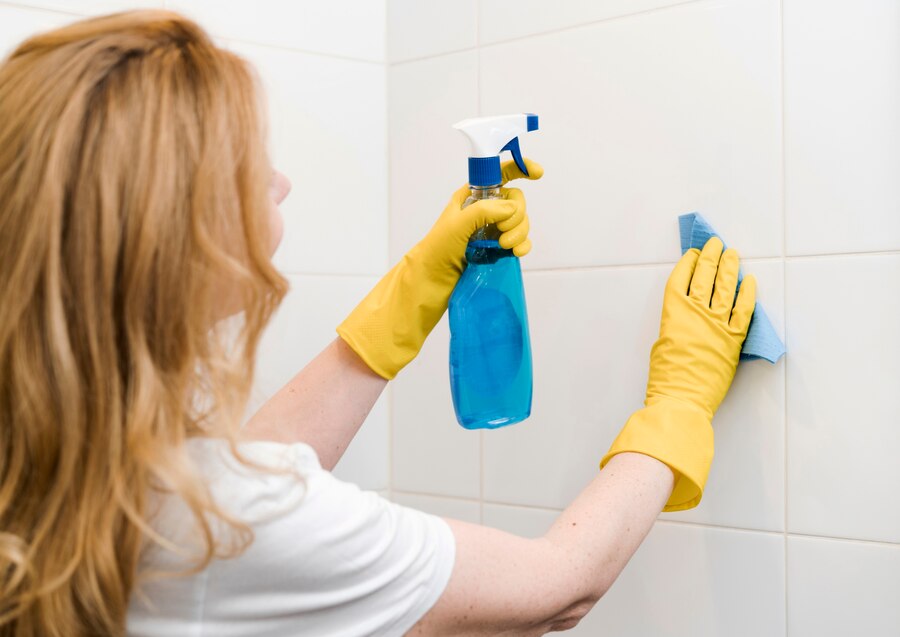
Grout cleaning might not sound glamorous, but it’s the unsung hero of pristine floors. Over time, grout—a mixture of cement, sand, and water—becomes a magnet for dirt, grime, and stains, dulling the once-lustrous tiles it binds. However, fear not; mastering grout cleaning can revive your floors and transform your living space.
Effective grout cleaning techniques are crucial for maintaining your home’s aesthetics and hygiene. Whether tackling a small kitchen backsplash or an expansive bathroom floor, understanding the proper methods is critical. From traditional scrubbing with baking soda and vinegar to advanced steam cleaning systems, there’s a method suited to every level of grime and every type of tile.
In this comprehensive guide to grout cleaning, we delve into essential tools, eco-friendly solutions, and expert tips to help you achieve sparkling results. Elevate your cleaning routine beyond sweeping and mopping—empower yourself with the knowledge to make your floors shine.
Understanding Grout: Composition and Importance
Grout from cement, sand, and water fills gaps and supports tiles. However, its porous nature traps dirt and stains, demanding regular maintenance. Knowing grout’s composition is vital; different types need specific cleaning methods.
Regular cleaning boosts aesthetics and prevents mold, extending grout lifespan. Understanding grout empowers homeowners to maintain beautiful, durable floors.
Essential Tools for Effective Grout Cleaning
Ensuring effective grout cleaning requires the right tools to tackle dirt and stains while preserving tile surfaces. These essential tools are fundamental for achieving professional-level results in maintaining clean and pristine grout lines.
- Stiff-bristled Brush: This brush is ideal for scrubbing grout lines to dislodge stubborn dirt and grime without damaging the grout or tiles.
- Grout Brush: Features nylon or metal bristles that reach deep into narrow gaps, ensuring thorough cleaning.
- Microfiber Cloths: Perfect for wiping away loosened grime and excess cleaning solution, leaving surfaces streak-free.
- Steam Cleaner: This device utilizes high-pressure steam to dissolve dirt and sanitize grout lines effectively without the need for harsh chemicals.
- Electric Toothbrush or Rotary Tool: These tools provide extra scrubbing power for tough stains while being gentle on grout and tiles.
Effective grout cleaning improves the appearance of your floors and extends their lifespan by preventing mold and mildew buildup. By investing in these essential tools and using them correctly, you can maintain cleaner grout lines and preserve the beauty of your tiled surfaces for years to come.
Preparing Your Workspace: Protecting Tiles and Surroundings
Before starting grout cleaning, prepare your workspace by covering adjacent surfaces and delicate fixtures with protective materials like plastic sheeting or painter’s tape. This shields tiles from harsh chemicals and keeps cleaning agents focused on grout lines.
Adequate ventilation, achieved by opening windows or using fans, promotes a safer environment by dissipating cleaning product fumes. These preparatory steps create a controlled workspace conducive to effective grout cleaning while safeguarding your tiled surfaces.
DIY Methods: Baking Soda, Vinegar, and Lemon Juice Solutions
DIY cleaning solutions using baking soda, vinegar, and lemon juice offer effective and eco-friendly alternatives for cleaning grout. Baking soda is a gentle abrasive, lifting dirt and stains without scratching tiles.
Vinegar dissolves mineral deposits and soap scum, leaving grout clean and refreshed, while lemon juice enhances cleaning power and adds a fresh scent. These methods are cost-effective and safer for the environment and household members, making them popular for regular grout maintenance.
Steam Cleaning: How to Use It Safely on Grout
Steam cleaning is a powerful method for deep cleaning grout. It utilizes high-temperature steam to dissolve dirt, grime, and even mold without harsh chemicals.
- Select the Right Steam Cleaner: Choose a steam cleaner with adjustable pressure settings for grout cleaning.
- Start at Low Pressure: Begin at the lowest pressure setting to avoid damaging grout or tiles.
- Work Methodically: Direct the steam nozzle along grout lines in small sections to penetrate and loosen embedded dirt.
- Use Proper Ventilation: Ensure adequate ventilation during and after cleaning to prevent moisture buildup and promote drying.
- Finish with Wiping: After steaming, wipe away loosened grime with a microfiber cloth or mop for a polished finish.
Incorporating these steps into your cleaning routine ensures that steam cleaning enhances cleanliness and protects the integrity of your grout and tiles.
The Power of Commercial Grout Cleaners: When and How to Use Them
Commercial grout cleaners are formulated to effectively tackle tough stains and deeply embedded grime that DIY methods often struggle to remove. Available in sprays, gels, and concentrates, these cleaners contain potent chemicals designed to break down stubborn deposits and restore grout to its original color.
When selecting a commercial cleaner, consider factors such as the type of grout and the severity of staining. Follow manufacturer instructions carefully, including wearing protective gloves and ensuring proper ventilation during application. Apply the cleaner directly onto grout lines, allowing it to sit for the recommended time to achieve maximum effectiveness.
Use a brush or scrubbing pad to agitate the cleaner, then thoroughly rinse with water to eliminate any residue. Commercial grout cleaners complement routine maintenance, ensuring grout remains clean and free from discoloration, preserving the pristine look of your tiled surfaces.
Brush Selection: Finding the Right Tool for Different Types of Grout
When cleaning grout effectively, choosing the right brush is essential to achieve optimal results without causing damage. Different types of grout, such as sanded and unsanded, require specific tools due to their varying compositions and susceptibility to abrasion.
- Stiff-bristled Nylon Brush: It effectively removes dirt and debris and is ideal for cleaning sanded grout.
- Grout Brush with Metal Bristles: Provides extra scrubbing power for tough stains on sanded grout.
- Soft-bristled Brush: Suitable for cleaning unsanded grout without causing abrasion.
- Toothbrush: Perfect for intricate areas and delicate unsanded grout lines.
- Electric Toothbrush with Oscillating Head: Offers efficient cleaning by gently agitating grout surfaces.
Choosing the right brush ensures thorough cleaning while protecting grout and tile surfaces. Whether tackling routine maintenance or deep cleaning sessions, having the correct tools on hand makes all the difference in achieving pristine grout lines and maintaining the overall appearance of your tiled floors.
Sealing Grout: Why It’s Important and How to Do It Correctly
Sealing grout is essential for protecting it against dirt, moisture, and stains, thus extending its lifespan and preserving its appearance. Because grout is naturally porous, it readily absorbs liquids and contaminants that can lead to discoloration and degradation over time. Applying a high-quality grout sealer forms a barrier that repels water and oils, reducing the risk of stains and mold growth.
Before sealing, ensure grout lines are clean and completely dry to ensure the sealer adheres appropriately. Choose a sealer suitable for your type of grout and tiles, such as cementitious or epoxy-based options. Apply the sealer evenly using a small brush or roller, working in small sections to ensure thorough coverage.
Allow the sealer to penetrate for the recommended time, then remove any excess with a clean cloth. For ongoing protection, consider reapplying the sealer periodically based on usage and exposure to maintain the grout’s resilience and keep it looking fresh.
Troubleshooting Stains: Addressing Stubborn Grout Discoloration
Stubborn grout stains can detract from the beauty of tiled surfaces, requiring specific cleaning methods for effective restoration. Common causes of grout discoloration include mold, mildew, hard water deposits, and spills. To combat mold and mildew, a diluted bleach solution can effectively eliminate spores and lighten stains, though cautious application is necessary to prevent damage.
Vinegar or commercial limescale removers are gentle options for tackling mineral deposits without aggressive scrubbing. For organic stains such as food or grease, baking soda, and water paste absorb oils and lift discoloration efficiently.
Always perform a patch test in an inconspicuous area before applying any cleaning solution broadly to avoid unintended damage. With persistence and the right approach, addressing stubborn grout stains restores the pristine appearance of tiled surfaces, enhancing the overall aesthetics of your home.
Maintenance Tips: Keeping Your Grout Clean and Shiny Year-Round
Maintaining clean and shiny grout throughout the year is essential for preserving the beauty and durability of your tiled surfaces. Regular upkeep enhances the appearance of your floors and prevents the buildup of dirt, grime, and stains that can compromise grout integrity over time.
- Establish a cleaning routine: Sweep or vacuum tiled floors regularly to remove dirt and debris from grout lines.
- Use gentle cleaning solutions: For routine cleaning, opt for mild dish soap diluted in water to avoid damaging grout.
- Avoid abrasive cleaners: Avoid harsh chemicals and abrasive tools that can scratch or erode grout.
- Inspect and address issues promptly: Regularly check grout for signs of wear, cracking, or discoloration, and take action as needed.
- Reapply grout sealer: Follow manufacturer recommendations to maintain a protective barrier against stains and moisture.
By incorporating these simple yet effective maintenance practices into your cleaning regimen, you can ensure that your grout remains clean, shiny, and resilient year-round.
Maintaining clean and sparkling grout is not just about aesthetics—it’s about preserving the integrity and longevity of your tiled floors. By understanding grout composition and employing effective cleaning techniques, homeowners can ensure their floors remain beautiful and durable.
From essential tools and DIY methods to advanced steam cleaning and commercial cleaners, various approaches suit every need and situation. Regular maintenance, including proper sealing and troubleshooting stubborn stains, is critical to keeping grout looking fresh year-round.
To simplify your grout cleaning needs and ensure professional results, consider calling Harris Cleaning Services at 910-333-3231. With their expertise and commitment to quality, they can handle the toughest grout cleaning challenges while preserving the beauty of your home’s tiled surfaces.
Don’t wait—take proactive steps today to enjoy cleaner, brighter floors tomorrow. Contact Harris Cleaning Services and experience the difference in your home maintenance routine. Let’s keep your grout shining and your floors looking their best!

